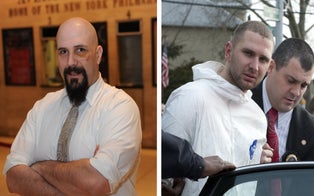The controversial career of Dr. Walter Freeman, a neurologist and a brain doctor who performed over 2,000 lobotomies during his career, began in the 1920s and 1930s.
Dr. Walter Freeman was a neurologist who performed over 2,000 lobotomies in the course of his career. Though he claimed to want to help people in mental wards, Freeman continued to do lobotomies even when they weren’t warranted.
Author Sam Kean tells the story of Dr. Freeman and other ethically suspect practitioners of science and medicine in his new book, “The Icepick Surgeon: Murder, Fraud, Sabotage, Piracy and Other Dastardly Deeds Perpetrated in the Name of Science." And he chatted with Inside Edition Digital about Dr. Walter Freeman’s story.
The controversial career of Dr. Walter Freeman, a doctor, a neurologist, and a brain doctor, began in the 1920s and 1930s.
“At the time, there was a big problem in most cities in that they had insane asylums where they kept people who had brain disturbances, who'd gone crazy. And doctors essentially had zero ways to treat these people,” Sam explains.
“There were no drugs available, no effective therapies, nothing they could do with them. They kept them in small locked rooms, often in straight jackets. And he was very moved by this, very affected by this. And he wanted badly to help them, to do something for them.”
This, unfortunately, led to him jumping feet first into a treatment now called the lobotomy.
“The basic idea of a lobotomy,” Sam states, “is that you have different parts of your brain, and you want to separate those two parts. So you have the frontal lobes, which control things like higher reasoning, planning, things like that. And then a little deeper inside your brain, you have structures called the limbic system.”
“Those are involved in processing emotions, And the theory at the time, we now know it was incorrect, but the theory at the time was that the emotional parts of the brain were getting revved up, running out of control. And they were overwhelming the frontal parts of the brain. So the idea essentially was to sever the connections between the frontal lobes and the limbic system inside the brain.”
The lobotomy was developed by Portuguese doctor Egas Moniz. But Freeman became the procedure’s most enthusiastic proponent. And Sam Kean reveals that Freeman used two different lobotomy techniques.
“The first technique was a full-on brain surgery,” he explained. “So they had an actual neurosurgeon there, anesthesiologist, everyone, full sterile setup, the whole thing.”
“They would go in, they would cut a hole on both sides of the brain. And they would put a, basically, a long metal shim in there, not sharp like a blade, but thin like a blade, in there. And they would start to swish it around in order to sever these connections between different parts of the brain.”
But then, according to Sam, Walter Freeman took this practice one step forward.
“Essentially, he looked at all of the insane asylums around the country, and he said, ‘We have hundreds of thousands of people. If we have to do a full-on surgery every single time, that will take forever. There's no way we're going to clear the insane asylums out like I want to do.’
Freeman then developed a way to do lobotomies very quickly, and Sam says he did them with normal ice picks.
“So what he would do, it was called the transorbital lobotomy because he would go in through the orbit, through the eye socket essentially,” he explains. “He would slide the icepick right up on the inside of the eye, break through the thin bone behind the eye socket, get it inside there and start swishing it around to sever those connections.”
And with this new procedure, he would tackle lobotomies much quicker. There were even times where he would do up to 25 lobotomies in a single day or would do two at once.
This, according to Sam, leads to Freeman taking his lobotomy show on the road.
“Freeman loved to take long summer road trips. And eventually, he decided to combine those with his lobotomy work by driving around the country, usually to small rural places, hopping from asylum to asylum.”
“He would get there, and they would have maybe a dozen patients, maybe two dozen patients lined up for him to do lobotomies on every single one of them.”
He then began performing the procedure as a preventative measure even when it wasn’t necessary. And not only on adults, but teenagers and young children.
“If he saw someone who might in the future develop a mental disorder and need to be institutionalized, something like that, he would say, ‘Hey, let's nip this in the bud. Let's prevent them from even getting into an asylum and perform it preemptively,’ Sam points out.
This, of course, was very dangerous because he was destroying healthy brain matter in these patients. He was also manipulating people whose brains had not fully developed yet.
Sam notes that that's where he really strayed from someone who was merely pushing the boundaries to someone who was “doing sinful science.”
Not surprisingly, the procedure had its risks, and there were different variations to how the patients reacted.
“In some cases,” Sam said, “he did actually do serious brain damage, and the person ended up, this wasn't common, but they did end up sort of like the Hollywood stereotype where they were drooling, could not take care of themselves, completely oblivious to everything around them.”
“The much more common outcome was, as he said, ‘they lost their sparkle.’ So they essentially lost their personality. So they might just be sitting in a room all day staring at the wall. They would have no ambition to do anything more. They would have no ambition. They had no wants, no real desires.”
According to Sam, Freeman’s best-known lobotomy patient may have been Rosemary Kennedy, younger sister of President John F. Kennedy.
“She grew up a little slow, a little different,” he reveals. “She was very high-spirited. She was fairly normal but just a little slower. And unfortunately, to the Kennedy family, who had big political ambitions, they thought of her essentially as an embarrassment. They didn't want her to be seen in public with them. They wanted to keep her in the shadows.”
This led to her father, Joseph Kennedy, talking with Walter Freeman. And eventually, the procedure was done on Rosemary.
The results were disastrous.
“Afterward, she couldn't speak very well," Sam said. "She couldn't use utensils, struggled to go to the bathroom, things like that. She eventually did recover to some degree where she could do basic everyday things. But after that, she just wasn't herself anymore. She lost her sparkle. She lost her personality. And she had to be institutionalized for the rest of her life.”
There were times when Freeman’s cavalier approach resulted in patient deaths as well.
“There were several cases where people died,” Sam states. “Either because he nicked an artery in the brain. Or, in one case (again, he liked to be around photographers, and he liked to photograph the cases himself), he had the icepick in the person's brain and stopped to take a picture, and it was at a bad angle and actually slid down to their midbrain. So the back of their brain that controls basic processes like breathing, wake/sleep cycles, things like that, and ended up killing the person on the table.”
Yet, Freeman never faced the consequences equal to his misdeeds, and he never faced any legal repercussions. However, he would lose his ability to perform operations at different hospitals.
“They would rescind that right,” Sam said. “And eventually, he did become a pariah in the medical community.”
Sam says Freeman’s sins may be attributed in part to his lack of scientific rigor.
“He really didn't do scientific studies because to do a scientific study. He should've set up a lobotomy group and a control group where you treat the lobotomy patients. Then you follow the control patients, compare their outcomes over time.”
“He never did that. He just jumped in and did everyone with a lobotomy and then came back later and said, ‘Hey, everyone's doing great. So you should all completely trust me on this.’ And that's just not how science works.”
Sam reveals that Freeman continued to perform lobotomies even after new drug treatments were introduced to help patients.
“And to his big discredit, even after the drugs came out, he tried to discredit them. He tried to smear them essentially because he wanted the lobotomy, again, to be the first treatment for anyone with mental illness.”
“He was just so convinced that his way was correct and it was the best way to do things. And any other treatment was not going to be as good. And that was it,” Sam lastly adds. He would just not listen to any common sense, any statistics, anything like that. He was convinced lobotomies were the only humane way to treat people.”
Walter Freeman performed his last lobotomy in 1967, and the patient died. Freeman himself died in 1972.





